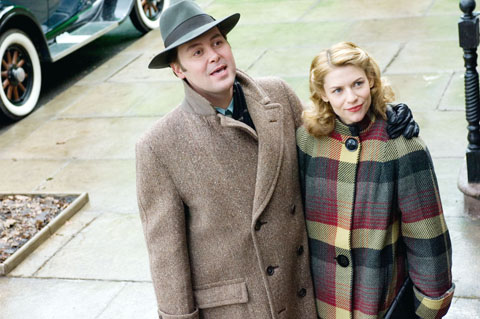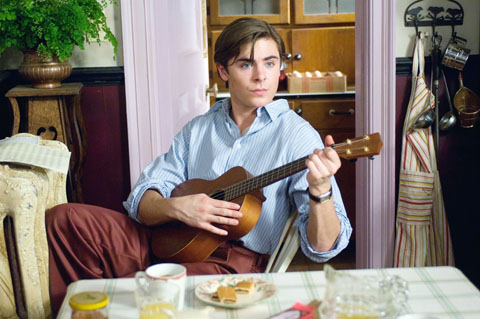Much of the success of Me and Orson Welles derives from Christian Mckay’s superb impersonation of the great theatrical impresario, who serves as director Richard Linklater’s shorthand for all the euphoric highs and devastating lows that is the business of showbiz. Me and Orson Welles is partly about Welles, but much more fundamentally, it is about the world of the theater.
The “Me” of the title is Richard Samuels (Zac Efron), an aspiring actor who stumbles into Welles’ landmark production of Julius Caesar through a mixture of youthful bravado, cheek and naivety. Given a minor role, taking over from some unnamed, unseen actor who has been a victim of Welles’ erratic and vindictive temper, Richard believes himself embarked on a magnificent journey. On his way, he experiences the superficiality, the precariousness and the self-aggrandizement of the theater. He also catches a glimpse of its grandeur and its power.
Though he doesn’t know it at the time, the wave he is riding is the wave of Welles’ theatrical genius, and this is very much shot through with other aspects of Welles’ supersized personality — egomania and vindictiveness. Although clearly in love with theater, Me and Orson Welles is also very aware of the darker side of theatrical life. Rather than dwelling on this darkness, it shines a light on it, gently mocking it for its absurdity and hypocrisy, but accepting also that this is an integral part of what makes theater so important and powerful.

In its mix of biography with painstaking attention to the minutiae of theatrical life, Me and Orson Welles brings to mind Mike Leigh’s Topsy-Turvy (1999), which looked at how the tempestuous relationship between Arthur Sullivan and W.S. Gilbert generated the G&S masterpiece of The Mikado. In Me and Orson Welles, the theatrical work in question was Welles’ production of Julius Caesar set in Fascist Italy under Mussolini, a groundbreaking work that would change the face of Shakespearean performance. The film gives a wonderful feel for how touch-and-go the whole enterprise was, consciously undermining Welles’ own heroic conception of himself and his enterprise. In fact, Welles manages the production in between numerous other projects and romantic entanglements. Other people, from producers to actors, are kept waiting for the great man to appear, and when he does, the force of his personality brings them to life.
Claire Danes puts in a splendid performance as Sonja Jones, a sweet little bundle of ambition who wants to break into movies and believes that Welles will provide a longed-for introduction. There is a romantic interlude with Richard that never for a minute sidelines her real goal, and depriving the handsome male lead of the girl gives Me and Orson Welles a degree of toughness that lifts it above merely light romantic drama.
There are moments, nevertheless, when the naivety of Efron’s character infects the scriptwriting, and the film veers dangerously toward a High School Musical cuteness, but there is too much grit in the supporting cast and such a clear-eyed view that behind the magic of theater lies a strange mix of egos and nerves, that all is easily forgiven.


May 26 to June 1 When the Qing Dynasty first took control over many parts of Taiwan in 1684, it roughly continued the Kingdom of Tungning’s administrative borders (see below), setting up one prefecture and three counties. The actual area of control covered today’s Chiayi, Tainan and Kaohsiung. The administrative center was in Taiwan Prefecture, in today’s Tainan. But as Han settlement expanded and due to rebellions and other international incidents, the administrative units became more complex. By the time Taiwan became a province of the Qing in 1887, there were three prefectures, eleven counties, three subprefectures and one directly-administered prefecture, with

It’s an enormous dome of colorful glass, something between the Sistine Chapel and a Marc Chagall fresco. And yet, it’s just a subway station. Formosa Boulevard is the heart of Kaohsiung’s mass transit system. In metro terms, it’s modest: the only transfer station in a network with just two lines. But it’s a landmark nonetheless: a civic space that serves as much more than a point of transit. On a hot Sunday, the corridors and vast halls are filled with a market selling everything from second-hand clothes to toys and house decorations. It’s just one of the many events the station hosts,

Two moves show Taichung Mayor Lu Shiow-yen (盧秀燕) is gunning for Chinese Nationalist Party (KMT) party chair and the 2028 presidential election. Technically, these are not yet “officially” official, but by the rules of Taiwan politics, she is now on the dance floor. Earlier this month Lu confirmed in an interview in Japan’s Nikkei that she was considering running for KMT chair. This is not new news, but according to reports from her camp she previously was still considering the case for and against running. By choosing a respected, international news outlet, she declared it to the world. While the outside world

Through art and storytelling, La Benida Hui empowers children to become environmental heroes, using everything from SpongeBob to microorganisms to reimagine their relationship with nature. “I tell the students that they have superpowers. It needs to be emphasized that their choices can make a difference,” says Hui, an environmental artist and education specialist. For her second year as Badou Elementary’s artist in residence, Hui leads creative lessons on environmental protection, where students reflect on their relationship with nature and transform beach waste into artworks. Standing in lush green hills overlooking the ocean with land extending into the intertidal zone, the school in Keelung